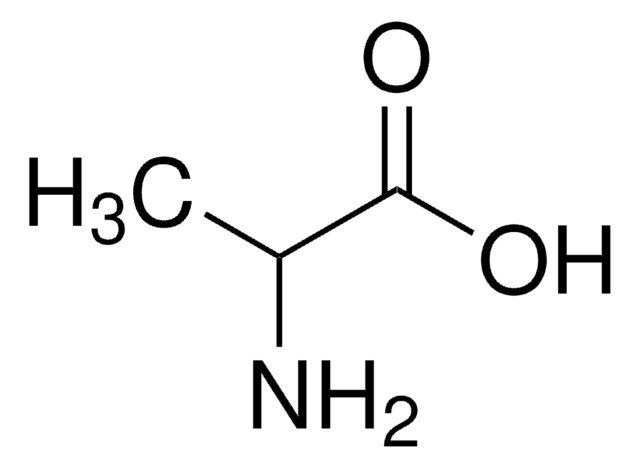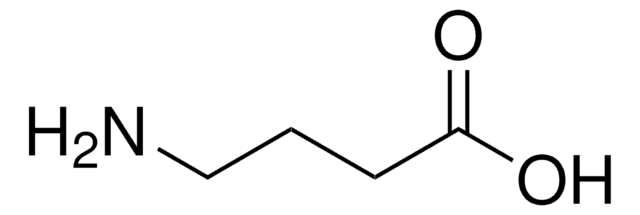Wszystkie zdjęcia(4)
Kluczowe dokumenty
A9006
DL-Aspartic acid
≥99% (TLC)
Synonim(y):
(±)-2-Aminosuccinic acid
Zaloguj sięWyświetlanie cen organizacyjnych i kontraktowych
About This Item
Wzór liniowy:
HOOCCH2CH(NH2)COOH
Numer CAS:
Masa cząsteczkowa:
133.10
Beilstein:
774618
Numer WE:
Numer MDL:
Kod UNSPSC:
12352209
Identyfikator substancji w PubChem:
NACRES:
NA.26
Polecane produkty
Nazwa produktu
DL-Aspartic acid, ≥99% (TLC)
Próba
≥99% (TLC)
Formularz
powder
kolor
white
mp
>300 °C (lit.)
rozpuszczalność
1 M HCl: soluble
Zastosowanie
cell analysis
peptide synthesis
ciąg SMILES
NC(CC(O)=O)C(O)=O
InChI
1S/C4H7NO4/c5-2(4(8)9)1-3(6)7/h2H,1,5H2,(H,6,7)(H,8,9)
Klucz InChI
CKLJMWTZIZZHCS-UHFFFAOYSA-N
Szukasz podobnych produktów? Odwiedź Przewodnik dotyczący porównywania produktów
Działania biochem./fizjol.
DL-Aspartic acid (DL-Asp) is a racemic mixture of the proteinogenic amino acid L-aspartate and the non-proteinogenic amino acid D-aspartate. DL-Aspartic acid is used in studies on factors and conditions that enhance semen and sperm quality.
Ta strona może zawierać tekst przetłumaczony maszynowo.
Kod klasy składowania
11 - Combustible Solids
Klasa zagrożenia wodnego (WGK)
WGK 1
Temperatura zapłonu (°F)
Not applicable
Temperatura zapłonu (°C)
Not applicable
Środki ochrony indywidualnej
Eyeshields, Gloves, type N95 (US)
Wybierz jedną z najnowszych wersji:
Masz już ten produkt?
Dokumenty związane z niedawno zakupionymi produktami zostały zamieszczone w Bibliotece dokumentów.
Klienci oglądali również te produkty
Jannick Jacobsen et al.
Dalton transactions (Cambridge, England : 2003), 48(23), 8433-8441 (2019-05-23)
Six different chiral and achiral alkane dicarboxylic C4-acids, i.e. succinic acid (H2SUC), dl-2-methylsuccinic acid (H2MS), 2,3-dimethylsuccinic acid (H2DMS) and aspartic acid (d-, l- and dl-H2ASP), were used to obtain Ce(iv)-MOFs via microwave assisted reactions. In water-based syntheses, MOFs with three
Xiong Deng et al.
Biochimica et biophysica acta, 1851(12), 1521-1529 (2015-09-04)
In hyperinsulinemic states including obesity and T2DM, overproduction of fatty acid and triglyceride contributes to steatosis of the liver, hyperlipidemia and hepatic insulin resistance. This effect is mediated in part by the transcriptional regulator sterol responsive element binding protein-1c (SREBP-1c)
Sarah Schmidt et al.
Journal of leukocyte biology, 98(1), 5-14 (2015-02-04)
The deoxynucleoside triphosphate triphosphohydrolase and 3' → 5' exonuclease SAMHD1 restricts HIV-1 infection in noncycling hematopoietic cells in vitro, and SAMHD1 mutations are associated with AGS. Little is known about the in vivo expression and functional regulation of this cellular
Ann-Louise Johansson et al.
Proceedings of the National Academy of Sciences of the United States of America, 110(22), 8912-8917 (2013-05-16)
Proton transfer across biological membranes underpins central processes in biological systems, such as energy conservation and transport of ions and molecules. In the membrane proteins involved in these processes, proton transfer takes place through specific pathways connecting the two sides
Alexandre Gouzy et al.
Nature chemical biology, 9(11), 674-676 (2013-10-01)
Here we identify the amino acid transporter AnsP1 as the unique aspartate importer in the human pathogen Mycobacterium tuberculosis. Metabolomic analysis of a mutant with an inactive AnsP1 revealed that the transporter is essential for M. tuberculosis to assimilate nitrogen
Chromatograms
application for HPLCapplication for HPLCNasz zespół naukowców ma doświadczenie we wszystkich obszarach badań, w tym w naukach przyrodniczych, materiałoznawstwie, syntezie chemicznej, chromatografii, analityce i wielu innych dziedzinach.
Skontaktuj się z zespołem ds. pomocy technicznej







